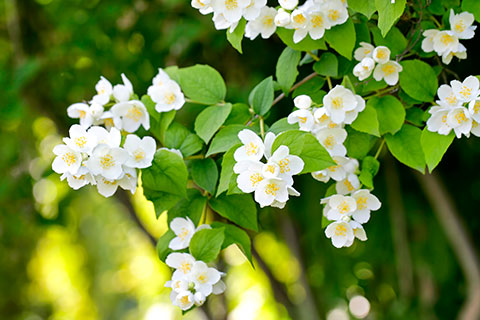- The most important thing to remember when creating a fragrant garden is that you want to be able to smell everything you’re planting. Consider placing plants in entryways, passageways, on patios, in courtyards and near windows you open regularly.
- Aromatic plants that aren’t particularly tall work well in hanging baskets or elevated containers, so they can be fully appreciated. The scents of shorter aromatic plants can be lost if they’re near the ground.
- Think about using a combination of plants which always fill the air with their scent and others that you can only smell when you’re very nearby. It’s also worth considering those that only smell as you brush past them for an element of surprise.
- Herbs are another obvious choice if scent is the primary objective for your garden. They will often offer a distinctive aroma on warm days, or if you pick and crush the leaves.
- Watering from overhead can interfere with strong smelling plants by limiting the release of nectar, so it’s worth using dripping techniques at the root and to avoid getting water on the plants.
- As tempting as it is to put everything into a fragrant garden, too many plants can be overpowering and in some cases, unpleasant, so try to limit what you choose to plant. Some plants, like Jasmine can be so strong that you only need one in your garden to really notice it, but others will need a few more planting to make the most of the scent.
- Plants such as Buddleja, Winter Sweet and Sarcococca grow throughout the colder part of the year and offer the most wonderful perfumed scents of lemon peel and almonds, while certain cultivars of Crocuses, Snowdrops and Aconites also have a strong scent.
- Don’t just limit yourself to fragrant flowers. Think about how you can use wood shavings, cut grass and damp autumn leaves to add another layer of scent and add to the overall atmosphere and fragrance of the garden.
- Often, more old-fashioned varieties of flowers tend to be more fragrant than modern hybrids. Dianthus, Gardenias, Nicotiana and Phlox are old-fashioned favourites that pack quite the punch when it comes to strong scents.
- Scented plants work particularly well on a patio or near to a seating area. Position containers close to the areas you spend most of your time in the garden to allow you to sit and truly enjoy the fragrances they exude.



Fragrant garden
Creating a fragrant garden isn’t just about filling your area with an overwhelming array of sweetly scented flowers. Of course flowers are responsible for a great deal of the fragrances in a garden, but there’s a lot more to consider. It’s also a commonly held belief that gardens are only pleasantly scented in spring and summer, but with a little bit of planning ahead, you can create an aromatic haven that is active all year round.
Our top design tips
The finishing touches
Some of the most fragrant plants, such as Clematis, Jasmine and Honeysuckle grow particularly well as climbers, so work well when grown over a pergola, up a trellis or along a wall. Choosing a fragrant smelling plant for your pergola will allow you to enjoy the scent while sitting under cover in your garden, while growing up a trellis or along a wall will ensure that the glorious aroma of the plants you’ve so carefully collected is right at nose level when you brush past.
And while we’re talking about enjoying the scent of the fragrant garden you’ve created, make sure there’s somewhere to sit and take it all in, even if you don’t choose to install a pergoda. A simple bench or bistro set will mean you can really enjoy the scents of your perfumed paradise.
The Fragrant Garden also works well when combined with the Cottage Garden style – be sure to learn how you can intertwine these designs to create a garden that’s rewarding for all the senses.







